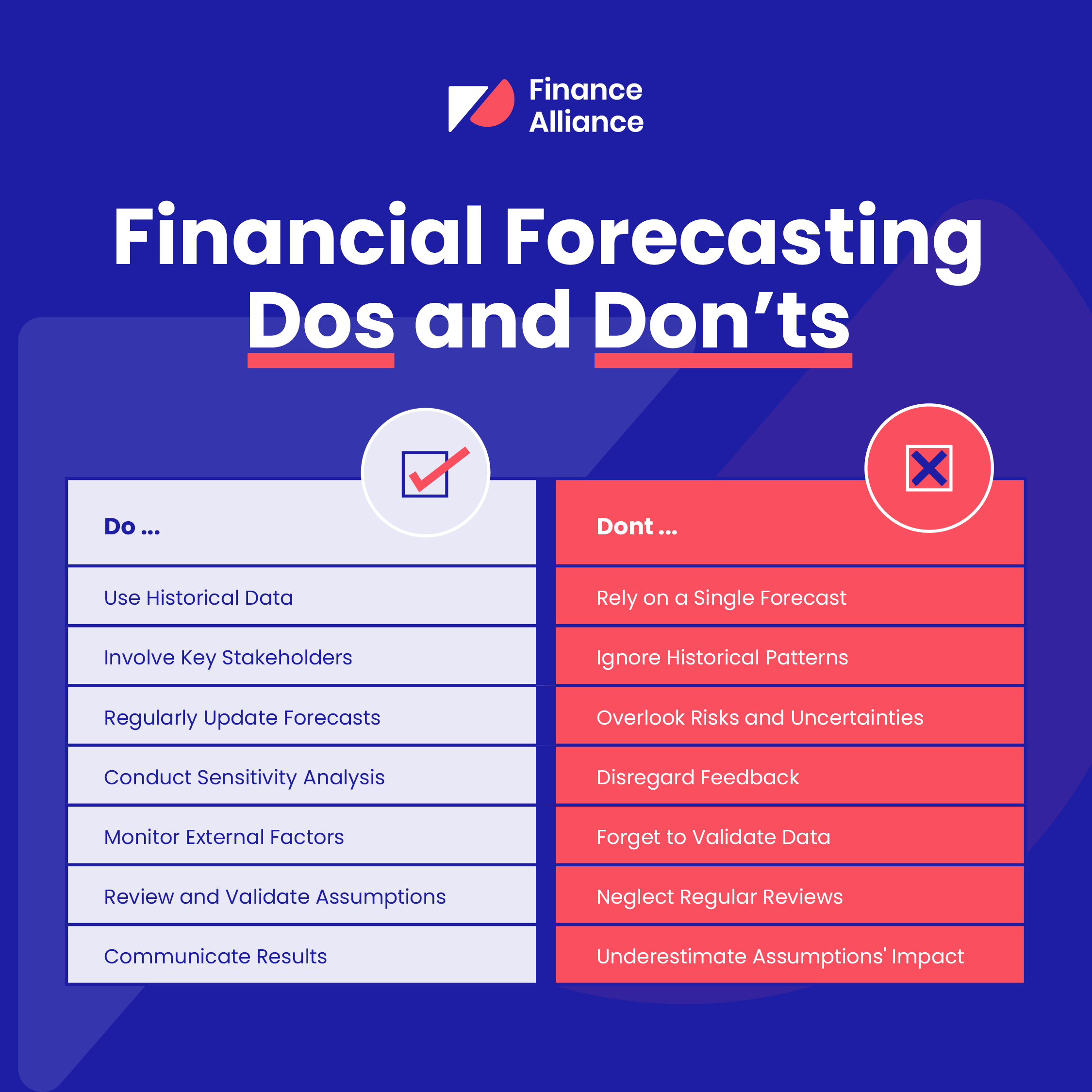Preparing an accurate financial forecast demands precision, attention to detail, and a clear understanding of the economic landscape.
But it's not just about the numbers. It's about knowing what to do (and what not to do) to ensure the accuracy and relevance of your forecast.
Below, we've curated seven dos and seven don’ts to fine-tune your forecasting process.👇

Do…
1. Use historical data
Why: Think of historical data as the footprints left behind on a trail. They show you where you've been and help guide where you're going. It's your chance to learn from the past.⌛
Example: Let's say you're working in a SaaS (Software as a Service) company. By looking at your historical churn rates (the percentage of customers who stop using your software), you can forecast future churn rates.
If you've been experiencing an average churn rate of 5% per quarter for the past two years, and there are no major changes in your market or business model, you could reasonably forecast a similar churn rate for the next few quarters.
This allows you to make informed decisions about customer retention strategies and calculate the number of new customers you need to maintain or grow your business.
2. Involve key stakeholders
Why: Many hands make light work, as the saying goes. Forecasting is a team sport, and including different departments ensures all angles are covered.
Example: If you're planning your company's cash flow forecast, involving the sales department can provide insights into expected deals closure, while your HR team can inform you about potential hiring or restructuring costs.
At the same time, the product department can share updates about upcoming launches or enhancements that might attract new customers or impact revenue. By inviting inputs from these different stakeholders, your financial forecast will be much more comprehensive and accurate.
3. Regularly update forecasts
Why: Your financial forecast isn't a static painting, it needs to change and grow with your business.
Example: Imagine your company secures a significant new client halfway through the year, resulting in a substantial increase in your projected revenues.
If you stick to your original sales forecast without updating it to account for this new development, you might miss out on opportunities to strategically reinvest this additional revenue back into your business.

4. Conduct sensitivity analysis
Why: It's like testing your ship for leaks before setting sail. You're exploring how different scenarios might impact your forecast, preparing for the unknown. ⛵
Example: What if fuel prices skyrocketed by 20%? By running a sensitivity analysis, you could see the projected increase in your operating expenses.
On the flip side, what if fuel prices were to drop by 10%? The analysis would show you the potential savings you might enjoy.
5. Monitor external factors
Why: Your business isn't an island; it's affected by the world around it. Keeping an eye on the broader landscape ensures you're not blindsided.
Example: Consider a coffee shop chain; political instability in coffee-producing regions might affect coffee bean prices. That's an external factor worth monitoring.
Another example is if you were a CFO at a technology firm (or any firm, really) that was heavily invested in the cloud services space. A crucial external factor for you would be regulatory changes in data privacy laws, such as GDPR (General Data Protection Regulation) in Europe or CCPA (California Consumer Privacy Act) in the United States.
If there are indications that a new country is planning to implement strict data privacy laws, it may impact how you can offer and price your cloud services in that market. Monitoring these external regulatory changes will allow you to adjust your financial forecasts, taking into account potential compliance costs or changes in revenue projections.
6. Review and validate assumptions
Why: Assumptions are the roots of your forecast. If these assumptions are flawed or unvalidated, your entire forecast becomes unreliable, potentially leading to misinformed decisions that can adversely affect your company's financial health.
Example: You may assume your business will grow revenue by 15% next quarter because you're launching a new product. However, this assumption shouldn't be based solely on optimism or past successes. It's crucial to validate this projection with solid data - perhaps you've conducted market research showing high interest in the product, or maybe your sales team has gathered promising feedback from key clients.
By continually reviewing and validating your assumptions, you ensure that your financial forecasts are not only based on realistic expectations but are also more likely to withstand scrutiny from stakeholders.
7. Communicate results
Why: A forecast kept under lock and key doesn't help anyone. It's a tool for the whole company to use and understand.
Example: A clear presentation of the forecast to different departments can spark valuable insights or ideas and help align everyone's goals.
Let's imagine you've forecasted a 25% increase in sales revenue for the next quarter based on expected market conditions and new product launches. Sharing this forecast with the Marketing team can help them plan their strategies to effectively support this growth. They might consider boosting advertising campaigns or crafting more targeted promotions to reach a larger audience.

Don't…
1. Rely on a single forecast
Why: Putting all your eggs in one basket is a risky move. A single forecast can't account for all the uncertainties your business might encounter.
Example: Imagine you run a tourism-based business. You wouldn't want to rely solely on a rosy forecast without considering potential disruptions, like a resurgence of travel restrictions due to a health crisis (remember Covid?).
2. Ignore historical patterns
Why: While it's important to look forward, ignoring the rearview mirror can lead to blind spots in your forecast.
Example: Let's say you're an FP&A professional at a software company that operates on a subscription-based model. Over the years, you've noticed a recurring pattern of increased subscription renewals and new customer acquisitions at the start of each fiscal year, likely due to many businesses setting their budgets for the year during this time.
Ignoring this historical pattern could lead to an underestimation of your revenue forecast for the first quarter. Therefore, when planning for the next fiscal year, it would be critical to take this seasonal trend into account to ensure that your revenue forecast is as accurate as possible. This would allow your company to plan and allocate resources more efficiently.
3. Overlook risks and uncertainties
Why: The future is murky and filled with unknowns. Not considering potential risks in your forecast is like walking on a tightrope without a safety net.
Example: A significant supplier going out of business could dramatically impact your production line.
4. Disregard feedback
Why: Feedback is a goldmine of insights. Ignoring it can lead to missed opportunities for refinement and improvement.
Example: As a finance professional, one of your key responsibilities is managing and forecasting the company's cash flow. The Sales team, for instance, could provide valuable feedback on their latest client interactions.
Let's say they've been hearing that some clients are struggling with payment deadlines due to market conditions. If you disregard this feedback, your forecast for cash inflow might be overly optimistic, leading to potential liquidity issues down the line.
By taking this feedback into account and adjusting the expected payment timings in your cash flow forecast, you can avoid potential surprises and ensure that you have a more accurate understanding of your company's future financial position. This more accurate forecast could then be used to renegotiate payment terms with clients or arrange for necessary financing ahead of time.
Such proactive financial management can enhance business stability and give your stakeholders increased confidence in your company's financial forecasts.

5. Forget to validate data
Why: Garbage in, garbage out. If your data isn't accurate, your forecast won't be either.
Example: A sudden spike in sales might be due to a one-off bulk order, not a trend. Including this in your forecast without data cleaning and validation could skew your results.
6. Neglect regular reviews
Why: A forecast is not a one-and-done deal. Without regular check-ins, your forecast might become outdated or irrelevant.
Example: A newly signed contract with a big client should trigger a review and potential adjustment of your sales forecast.
7. Underestimate assumptions’ impact
Why: Even small changes in your assumptions can cause big swings in your forecast. Ignoring this can lead to unpleasant surprises.
Example: Suppose you're a CFO for a company with significant reliance on raw materials, like a manufacturing or construction company. You've assumed a stable cost for these raw materials in your financial forecast. However, market conditions can be unpredictable, and even a slight increase in raw material costs can have a significant impact on your cost of goods sold (COGS) and, consequently, your profit margins.
For instance, if raw material costs increase by just 5%, this could lead to a substantial drop in your profit margin, especially if these costs represent a large portion of your total expenditure. Underestimating the impact of such an assumption in your forecast could result in an overestimation of your future profits, potentially leading to misinformed decision-making about investments, growth strategies, or shareholder dividends.
By acknowledging and carefully considering the potential impact of your assumptions, you can create more robust and reliable financial forecasts, capable of better withstanding unexpected market shifts.
FAQs
How often should I update my financial forecasts?
There's no one-size-fits-all answer, but generally, a quarterly review and update is a good starting point. However, if significant changes occur in your business or market environment, you should update your forecasts accordingly.
How far into the future should my financial forecast extend?
It depends on the nature of your business and industry. However, a 12-month forecast is commonly used for operational planning, while a 3-5 year forecast can be useful for strategic planning and investor relations.
How can I improve the accuracy of my financial forecasts?
Regularly review and update your forecasts, validate your data, and ensure your assumptions are realistic. Involving key stakeholders and incorporating their insights can also improve forecast accuracy.
What do I do when unforeseen factors affect my financial forecast?
When unexpected events occur, it's time to reassess your forecasts. Adjust your assumptions, consider the impacts, and revise your forecasts to reflect the new reality. It's all part of staying agile and responsive.
What factors should be considered when preparing financial forecasts?
When forecasting, you should take into account historical data, current market conditions, feedback from stakeholders, potential risks and uncertainties, and the impact of external factors. It's also crucial to validate your data and assumptions.
What are some common mistakes made when forecasting financial statements?
Some common pitfalls include relying too heavily on historical data without considering current market trends, overlooking external factors, and ignoring risks and uncertainties. It's also common to see over-optimistic or overly conservative assumptions that don't align with reality, as well as lack of regular reviews and updates.
Keep up with us!
Keep up with the latest releases on the Finance Alliance blog and podcast and be the first to know about upcoming events, reports, and industry news!
Subscribe to The Monthly Balance newsletter.




 Follow us on LinkedIn
Follow us on LinkedIn




